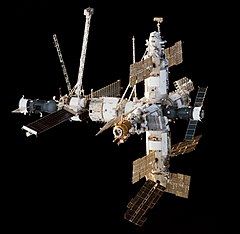Mir

|
|

Mir insignia
|
|
| Station statistics | |
|---|---|
| COSPAR ID | 1986-017A |
| Call sign | Mir |
| Crew | 3 |
| Launch | 20 February 1986 – 23 April 1996 |
| Launch pad |
LC-200/39, and LC-81/23, Baikonur Cosmodrome LC-39A Kennedy Space Center |
| Reentry | 23 March 2001 05:59 UTC |
| Mass | 129,700 kg (285,940 lb) |
| Length | 19 m (62.3 ft) from core module to Kvant-1 |
| Width | 31 m (101.7 ft) from Priroda to docking module |
| Height | 27.5 m (90.2 ft) from Kvant-2 to Spektr |
| Pressurised volume | 350 m³ |
| Atmospheric pressure | c.101.3 kPa (29.91 inHg, 1 atm) |
| Perigee | 354 km (189 nmi) AMSL |
| Apogee | 374 km (216 nmi) AMSL |
| Orbital inclination | 51.6 degrees |
| Orbital speed | 7.7 km/s (27,700 km/h, 17,200 mph) |
| Orbital period | 91.9 minutes |
| Orbits per day | 15.7 |
| Days in orbit | 5,510 days (15 years and 31 days) |
| Days occupied | 4,592 days |
| Number of orbits | 86,331 |
| Statistics as of 23 March 2001 (unless noted otherwise) References: |
|
| Configuration | |

Station elements as of May 1996
|
|
Mir (Russian: Мир, IPA: [ˈmʲir]; lit. peace or world) was a space station that operated in low Earth orbit from 1986 to 2001, run by the Soviet Union and later by Russia. Mir was the first modular space station and was assembled in orbit from 1986 to 1996. It had a greater mass than any previous spacecraft. At the time it was the largest artificial satellite in orbit, succeeded by the International Space Station after Mir's orbit decayed. The station served as a microgravity research laboratory in which crews conducted experiments in biology, human biology, physics, astronomy, meteorology and spacecraft systems with a goal of developing technologies required for permanent occupation of space.
Mir was the first continuously inhabited long-term research station in orbit and held the record for the longest continuous human presence in space at 3,644 days, until it was surpassed by the ISS on 23 October 2010. It holds the record for the longest single human spaceflight, with Valeri Polyakov spending 437 days and 18 hours on the station between 1994 and 1995. Mir was occupied for a total of twelve and a half years out of its fifteen-year lifespan, having the capacity to support a resident crew of three, or larger crews for short visits.
...
Wikipedia

